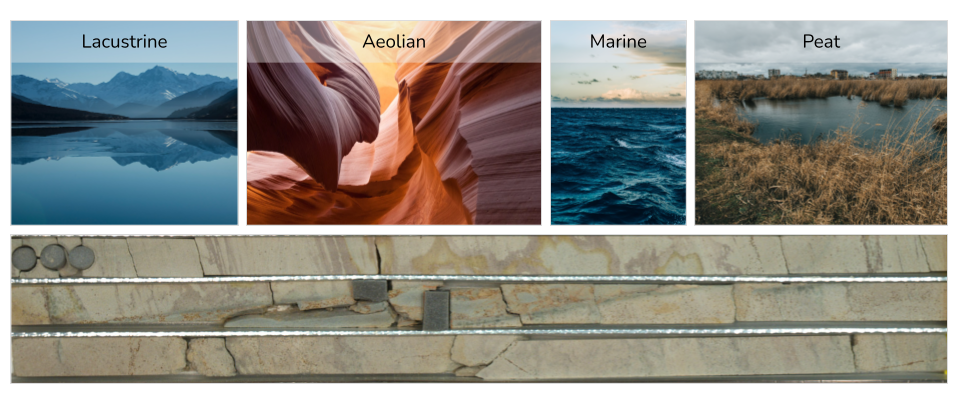Analysing lake sediment cores: from dating to paleoclimate reconstructions
Sediments used for climate and environmental reconstructions come in many different forms (including lacustrine, marine, peat, terrestrial and aeolian deposits) and can be characterized by their grain size, shape, sedimentary facies, chemical and biological composition and accumulation/sedimentation rate. Such sediments are collected in core form for further analysis of sediment layers (laminations), allochthonous material (e.g. charcoal, detrital matter, volcanic ash) and organisms within the sediment (e.g. pollen, diatoms, foraminifera).

In order to utilise sediment and sediment constituents for environmental / paleoclimate reconstructions, the individual layers must first be dated. Dating of sediments can be completed in a variety of ways, depending on the sediment type and age.
Radiocarbon (14C) Dating can be used to date any carbon bearing material based on the measurement of the decay of radioactive carbon-14. In the case of sediment cores, the bulk sediment or macrofossil fraction can be used for dating. Due to the complexity of sediment geochemistry, it is generally best to date extracted macrofossils or organic content if possible. Radiocarbon dating of sediments is generally accurate from present day until 50,000 years before present. However, challenges include the marine reservoir effect, the old water effect and age biases due to plant intrusions. Read more about radiocarbon dating of sediments and reservoir effects.
Uranium-Thorium (U-Th) Dating can be used to date shell material within sediment cores based on the analysis of 234U and 230Th. This dating process is viable between present day and 500,000 years before present. The accuracy is challenged by the open system nature of sediment carbonates, however isochron dating can be applied to reduce this age bias. Read more about U-Th dating and applications to shells and other carbonates.
Strontium (87Sr/86Sr) Dating can be applied to marine carbonates for a period spanning the last 500 million years. These marine carbonates take up strontium during their formation in ratios identical to that of the surrounding seawater. This 87Sr/86Sr ratio of the ocean varies through time, creating a predictable seawater curve that can be used for dating calibration. However, the accuracy of this method is not consistent through time, and works best during periods of long-term uni-directional shifts in 87Sr/86Sr, such as during the Tertiary. Read more about 87Sr/86Sr dating and stratigraphy.
Once the chronology of sediment samples have been established, further isotopic analyses may be applied to analyse changes in environmental conditions through time.
Oxygen isotopes (δ18O) can be analysed in carbonates to reconstruct temperature variability over time. The light (16O) and heavy (18O) species of oxygen vary in proportion depending on evaporation and condensation of rain as well as the movement of air within the atmosphere. For example, during ice ages when cool temperatures extend southward to the equator, the rainout of heavy oxygen occurs further south, resulting in even lighter (depleted δ18O) at higher latitudes. Read more about utilising oxygen isotopes in sediments and other carbonates.
Carbon isotopes (δ13C) can be used to analyse changes in photosynthesis, upwelling processes, sea/lake level, surrounding terrestrial erosion and more broadly, atmospheric circulation. These isotopes are more difficult to interpret than δ18O and are highly dependent on the location and sample type in question. For example, more negative δ13C can be indicative of increased continental weathering or older waters (limited downwelling) in benthic foraminifera and potentially increased upwelling and decreased local productivity in planktic foraminifera. Read more about utilising carbon isotopes in sediments and other carbonates.
Lead isotopes (206Pb, 207Pb, 208Pb) can be measured in sediments to identify periods of heavy metal contamination & atmospheric lead pollution. Given the distinct isotopic signatures of different lead sources, it’s possible to distinguish both the timing, pathway and type of contamination. For example, the aerosol deposition of coal pollution has been identified by comparing 206Pb/207Pb to 208Pb/207Pb in a reservoir sediment core (Xu & Gao, 2020). Read more about Lead Isotope applications.
| Isotope | Analysis application(s) | Sample size requirements* |
| Radiocarbon (14C) | Dating
(present to 50,000 cal BP) |
1-10g |
| Uranium-Thorium (U-Th) | Dating
(present to 500,000 cal BP) |
100-150mg (shell), 30-50mg (coral) |
| Strontium (87Sr/86Sr) | Dating
(present to 500 million years ago) |
10mg (forams), 100-150mg (shells, coral, carbonates) |
| Oxygen isotopes (δ18O) | Temperature reconstructions | 2mg |
| Carbon isotopes (δ13C) | Photosynthesis, upwelling processes, sea/lake level, erosion | 2mg |
| Lead isotopes (206Pb, 207Pb, 208Pb) | Heavy metal contamination and lead pollution | 50mg |
*Contact the laboratory for exact size requirements, which depend on the type, preservation and pretreatment status of the sample
References
Xu, D. and Gao, B. (2020). “Lead Isotopes Combined with Geochemical Baseline in Sediments: A Novel Tool to Trace Anthropogenic Pb Sources.” International journal of environmental research and public health, 17(3), p.1112
Image Sources
Lake: https://www.pexels.com/photo/calm-body-of-lake-between-mountains-346529/
Desert: https://www.pexels.com/photo/antelope-canyon-33041/
Ocean: https://www.pexels.com/photo/blue-and-white-abstract-painting-1802268/
Swamp: https://www.pexels.com/photo/brown-grass-near-body-of-water-3708614/
Sediment cores: https://upload.wikimedia.org/wikipedia/commons/6/6c/CRP-sediment-core-section_hg.jpg
Sediment cores: https://commons.wikimedia.org/wiki/File:PS1920-1_0-750_sediment-core_hg.jpg
